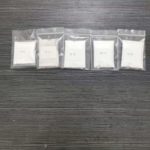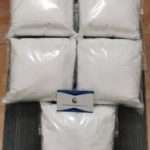1. Identification
(1) Lidocaine hcl powder
1. Preparing the derivative to measure the melting point and reacting with trishoylphenol to form a yellow precipitate.
2. React with heavy metal ions. In the sodium carbonate test solution, it reacts with copper sulfate to form a blue-violet coordination compound, which is yellow when dissolved in chlorine.
3. Chloride reaction
4. Infrared spectroscopy
(2) Tetracaine hcl powder
1. Preparing derivatives to measure melting point Dissolve in 5% acetic acid solution and add 25% ammonium thiocyanate to precipitate white crystals of thiocyanate.
2. Color reaction Add water to dissolve and then add nitric acid to generate N-nitroso compound, showing yellow color.
3. Chloride reaction
4. Infrared spectroscopy
2. Assay
Aliphatic amine side chain has tertiary amine nitrogen atom, which is alkaline, and its content is determined by non-aqueous titration method.
Lidocaine hcl powder is the hydrochloride salt. It is titrated with perchloric acid to produce hydrohalic acid, which is not conducive to the quantitative reaction. Before titration, add mercury cu acid to eliminate interference.
The content determination of tetracaine hcl powder is the same as that of lidocaine hcl powder. Adding an appropriate amount of acetic anhydride before titration can enhance the alkalinity of tetracaine hcl powder and make the end point of the titration sharp.
3. Analysis of acetaminophen
1. Identification
1. The reaction of ferric chloride has phenolic hydroxyl group, and the test solution of FeCl3 shows blue-purple
2. Diazotization-coupling reaction after hydrolysis
Hydrolysis produces aromatic primary amino groups, which can undergo diazotization reactions, and the resulting diazonium salts can be coupled with basic β-naphthol to form colored azo dyes.
3. Infrared spectroscopy
2. Special impurity inspection
1. Related substances Due to the many production process routes of this product, the impurities brought in by different production process routes are also different. These impurities mainly include intermediates, by-products and decomposition products. For example: p-aminophenol, p-chloroacetanilide, O-acetyl paracetamol, azobenzene, azobenzene oxide, benzoquinone and quinoneimine. The pharmacopoeia uses thin-layer chromatography with p-chloroacetanilide as a reference substance to check the limits of this impurity.
2. Para-aminophenol In the synthesis process of this product, due to incomplete acetylation or improper storage and hydrolysis, para-aminophenol can be introduced to make this product color and toxic to the human body. The limit should be strictly controlled. Using p-aminophenol can generate blue coordination compound with nitrosoferricyanide na under alkaline conditions, but paracetamol does not have the characteristics of this reaction. Compared with the reference substance, a limit check is carried out. The limit is 0.005%
Three, content determination
Acetaminophen has a maximum absorption at a wavelength of 257nm in 0.4% sodium hydroxide solution, and its ultraviolet absorption spectrum characteristics can be used for the content determination of its raw materials and preparations. Compared with the sodium nitrite titration method, this method is more sensitive and easy to operate. The Chinese Pharmacopoeia uses the percent absorption coefficient method to determine the content of acetaminophen raw materials, tablets, injections, and suppositories.
Four, toxicity comparison
Lidocaine hcl powder
Conculsions can occur when the blood drug concentration exceeds 5μg·ml-1. At low doses, this product can promote intracardiac cell K+ efflux, reduce myocardial autonomy, and have anti-ventricular arrhythmia effects; in therapeutic doses The electrical activity of myocardial cells, atrioventricular conduction and myocardial contraction have no significant effect; further increase in blood drug concentration can cause cardiac conduction velocity to slow, atrioventricular block, inhibit myocardial contractility and decrease cardiac output. (1) Lidocaine hcl powder can act on the central nervous system, causing drowsiness, paresthesia, muscle tremors, convulsions, coma, and respiratory depression. (2) Lidocaine hcl powder can cause hypotension and bradycardia. Excessive blood concentration can cause atrial conduction velocity to slow, atrioventricular block, and inhibit myocardial contractility and decrease in cardiac output.
Tetracaine hcl powder
1. Toxic reaction: The potency of this product is 10 times that of procaine, the toxicity is also 10 times higher than that of China procaine powder, and the incidence of toxic reactions is also higher than that of China procaine powder, often due to large doses, fast absorption or Caused by improper operation, such as accidentally injecting into the blood vessel to make the blood drug concentration too high. Symptoms of poisoning caused by overdose include dizziness, dizziness, chills, tremors, panic, and convulsions and coma, respiratory failure and blood pressure drop, and prompt rescue. 2. Change tai reaction: Tetracaine hcl powder can cause sudden death to allergic patients, even if it is surface anesthesia, it should be noted. 3. Can produce skin rash or urticaria, face, mouth or (and) glossopharyngeal area edema, etc.
 Lidocaine powder, phenacetin powder and Tetracaine powder bought by Germany customer–Aug 17,2022
Lidocaine powder, phenacetin powder and Tetracaine powder bought by Germany customer–Aug 17,2022 Lidocaine powder,Procaine powder,phenacetin powder and Tetracaine powder bought by Spainish customer on Mar 10,2022
Lidocaine powder,Procaine powder,phenacetin powder and Tetracaine powder bought by Spainish customer on Mar 10,2022 Lidocaine powder, phenacetin powder and Tetracaine powder bought by Germany customer–Aug 17,2022
Lidocaine powder, phenacetin powder and Tetracaine powder bought by Germany customer–Aug 17,2022 Lidocaine powder,Procaine powder,phenacetin powder and Tetracaine powder bought by Spainish customer on Mar 10,2022
Lidocaine powder,Procaine powder,phenacetin powder and Tetracaine powder bought by Spainish customer on Mar 10,2022











